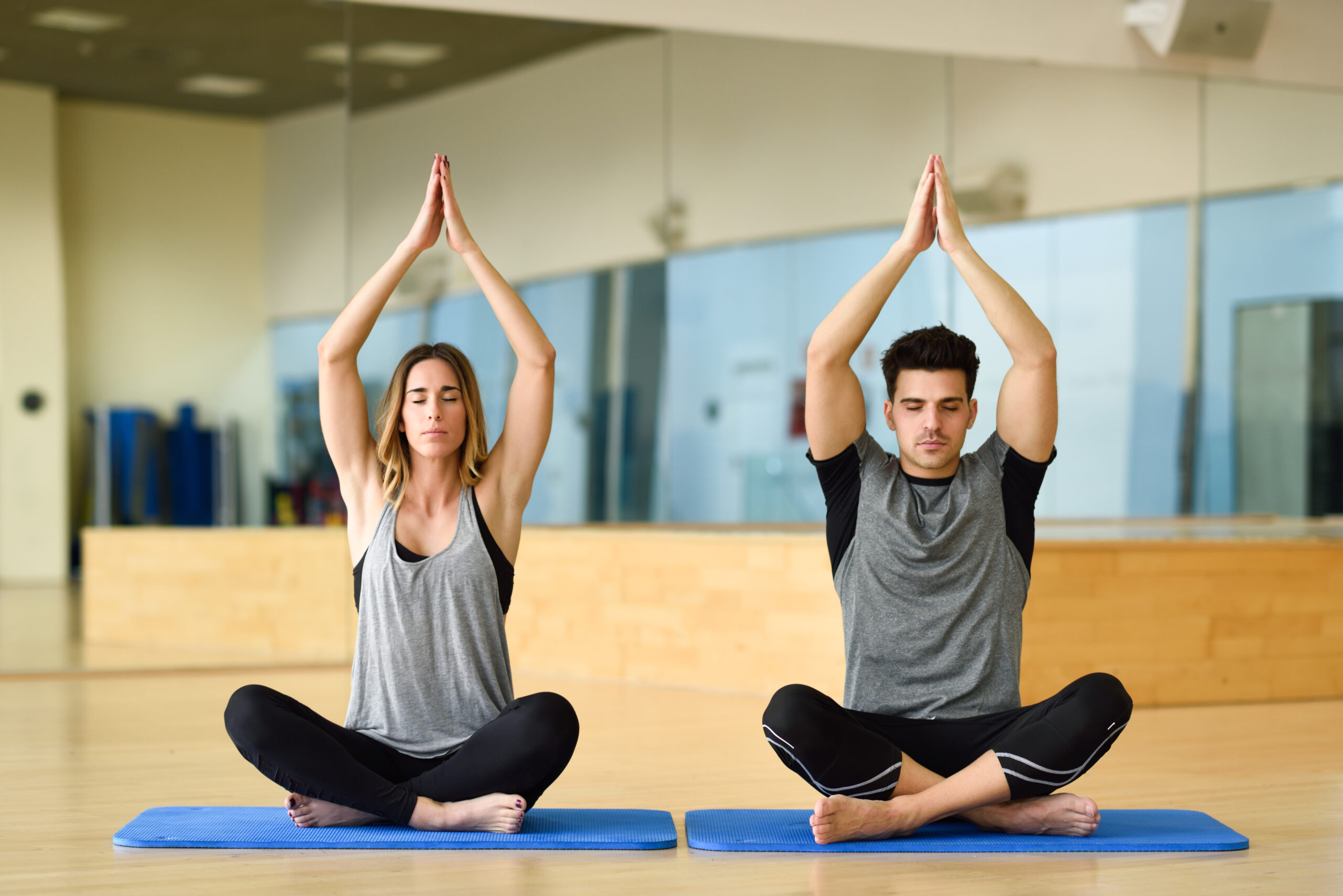In today’s fast-paced world, finding ways to connect and strengthen our relationships has become increasingly important. Couples yoga offers a unique and effective way to bond with your partner while promoting physical and emotional well-being. In this article, we will explore 15 couples yoga poses that can help strengthen your relationship and bring you closer together.
Benefits of Couples Yoga
Couples yoga offers numerous benefits that can enhance your relationship in various ways. Here are some key advantages:
- Increased Trust: Practicing yoga together requires trust and communication, fostering a deeper connection between partners.
- Enhanced Communication: Couples yoga encourages effective communication, as partners need to coordinate their movements and support each other.
- Strengthened Intimacy: Engaging in shared physical activities can reignite the spark in your relationship and strengthen the emotional bond between you and your partner.
- Improved Flexibility and Strength: Regular couples yoga sessions can help both partners improve their flexibility, strength, and overall fitness levels.
- Stress Relief: Yoga is known for its calming effects, and practicing it as a couple can help you both manage stress and find relaxation together.
Getting Started: Tips for Beginners
Before you embark on your couples yoga journey, keep the following tips in mind:
- Choose a Suitable Space: Find a quiet and comfortable space where you and your partner can practice without distractions.
- Use Yoga Mats: Invest in good-quality yoga mats to provide stability and cushioning during poses.
- Warm-Up: Begin your session with gentle warm-up exercises to prepare your body for practice.
- Communicate and Listen: Effective communication is key. Talk to each other about your expectations, preferences, and any physical limitations you may have.
- Respect Each Other’s Boundaries: Remember that everyone’s flexibility and strength levels differ. Respect your partner’s limitations and support them throughout the practice.
Couples Yoga Poses to Strengthen Your Relationship
1. Supported Sukhasana
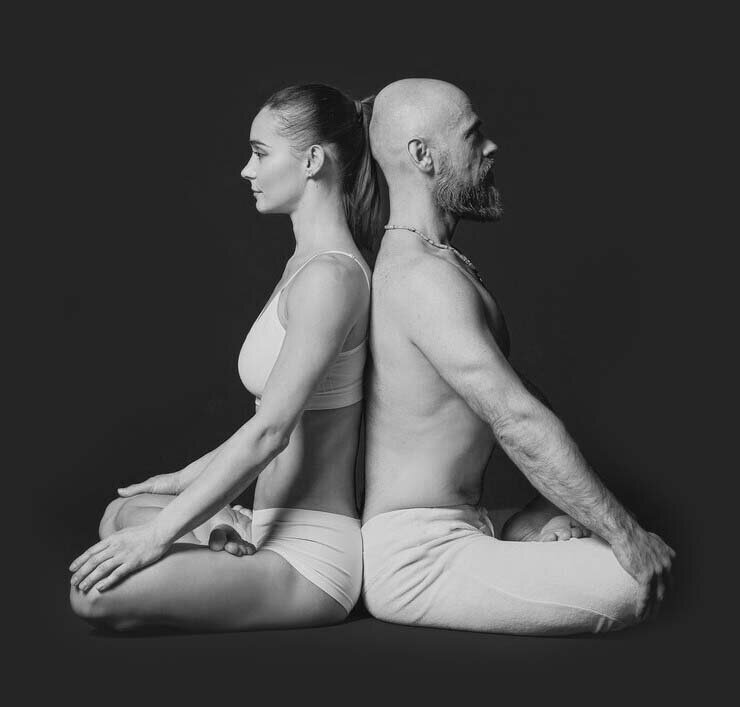
Description: Commence by assuming an uncomplicated seated position with your legs crossed, facing away from your partner, ensuring that your backs maintain full contact. Exert pressure with your upper backs, pressing them firmly against each other, while placing your hands on your knees to serve as a reminder to smoothly glide your shoulder blades downwards, away from your ears. Observe how the act of being in contact with your partner tends to synchronize your breathing patterns. Utilize this opportunity to synchronize in other ways as well, be it through conversation, shared silence, or the harmonization of breath.
Benefits: By utilizing each other as a supportive “wall” against which to press your back, you can achieve an elongated spine and a straight posture.
This position serves as an excellent foundational pose for ANY partner yoga practice, establishing a comfortable physical connection before delving into deeper postures.
2. Double Tree
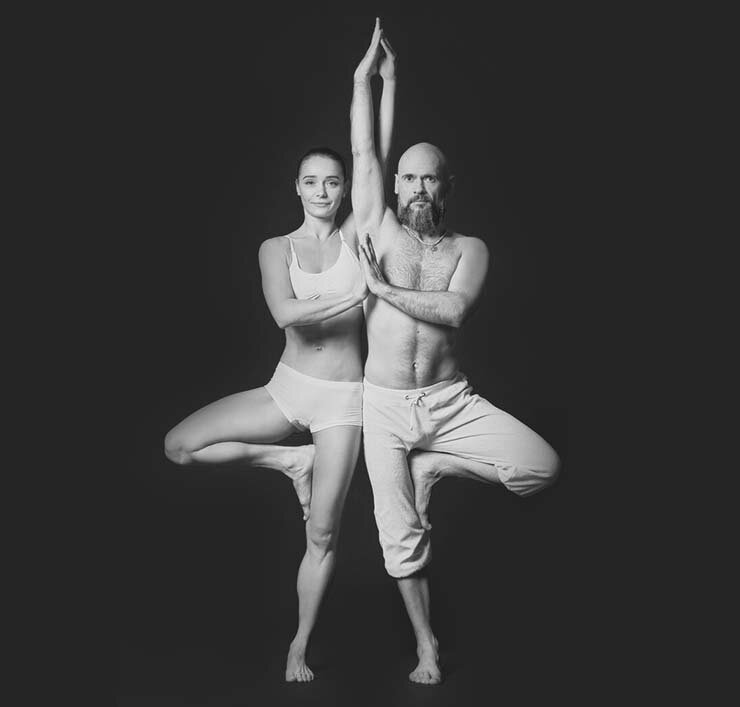
Description: Position yourselves side by side, standing hip-to-hip with a distance of approximately 1 foot between you and your partner. Raise your inner arms straight up towards the sky, rotating them outward from the shoulder sockets, allowing your palms to press against each other. Place your outer hands in front of you, as if assuming a prayer mudra, but instead, press your outer hand against your partner’s outer hand. Before transitioning into the tree pose, ensure that you check your alignment. Despite your inner arms being raised, your shoulders should remain relaxed and away from your ears.
Make an effort to evenly press through your palms, avoiding any leaning or imbalance (*tip: perform this in front of a mirror). Both partners lift their outer foot into the tree pose while keeping their inner foot grounded as the supporting leg.
Benefits: While the tree pose on its own enhances balance, this particular variation aids in learning how to distribute weight evenly between you and your partner. Additionally, it fosters improved communication and trust between both partners.
3. Double Boat
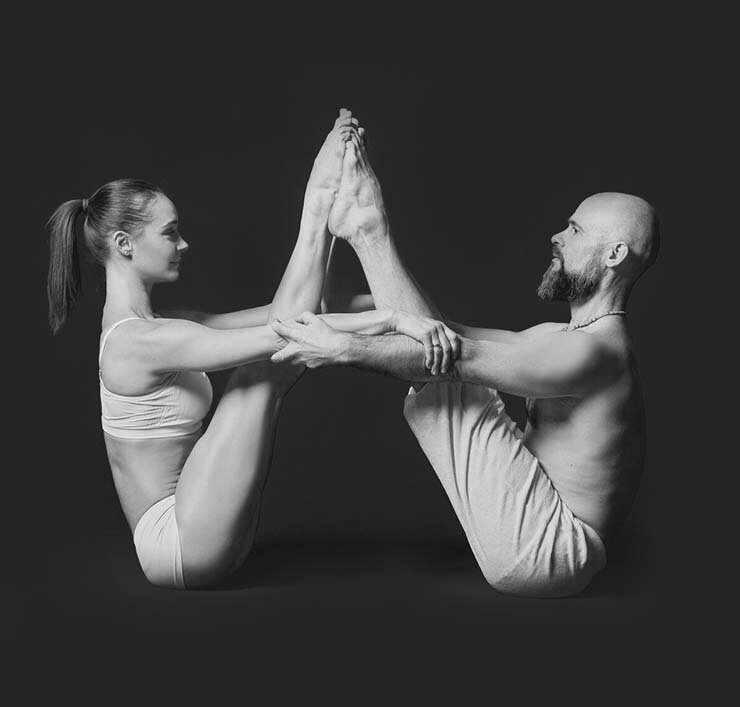
Description: Face your partner, both of you with your knees bent, feet flat on the mat, and toes touching each other’s. Extend your arms and grasp each other’s hands. While maintaining your grip, lean back as far as you comfortably can, raising your right foot (your partner’s left foot) off the mat, creating a 90-degree angle with your legs. Press the soles of your feet against each other. Once you find stability in this position, lift your second foot off the mat and press the soles of both feet against your partner’s. Now, you will be holding hands with all four legs off the ground, with the soles of your feet firmly connected.
Engage your core by activating your belly button and lift your spine upright as you simultaneously straighten your legs with your partner. This will transition you both into the boat pose, with your feet pressing against each other.
Benefits: If you struggle with the regular boat pose due to a lack of core strength, this variation is an excellent alternative. It requires less strength and places less stress on your hip flexors.
4. Plow and Seated Forward Fold
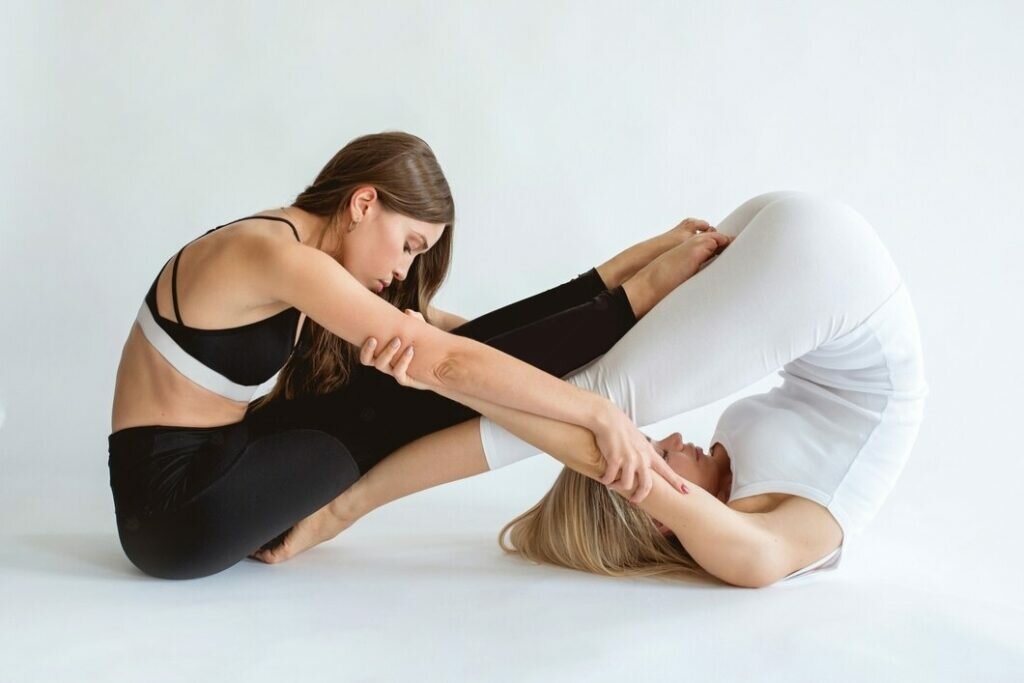
Description: Partner 1 (P1) starts in the Plow Pose with arms extended overhead towards the toes, while tucking the toes to press them firmly into the mat. Partner 2 (P2) sits directly in front of P1’s feet, which are folded overhead in the plow position, and bends their legs so that the soles of their feet rest on the mat. P2 grasps P1’s hands and leans back, creating space to lift their legs off the mat and extend them on top of P1’s legs. Both P1 and P2 walk their hands up each other’s arms, deepening the stretch.
Note: Throughout the practice, P1 should refrain from turning their head as it can lead to severe neck injuries.
Benefits: This pose creates a visually striking image resembling the infinity symbol. Beyond its aesthetic appeal, it provides an excellent hamstring stretch for both partners.
5. Double Plank
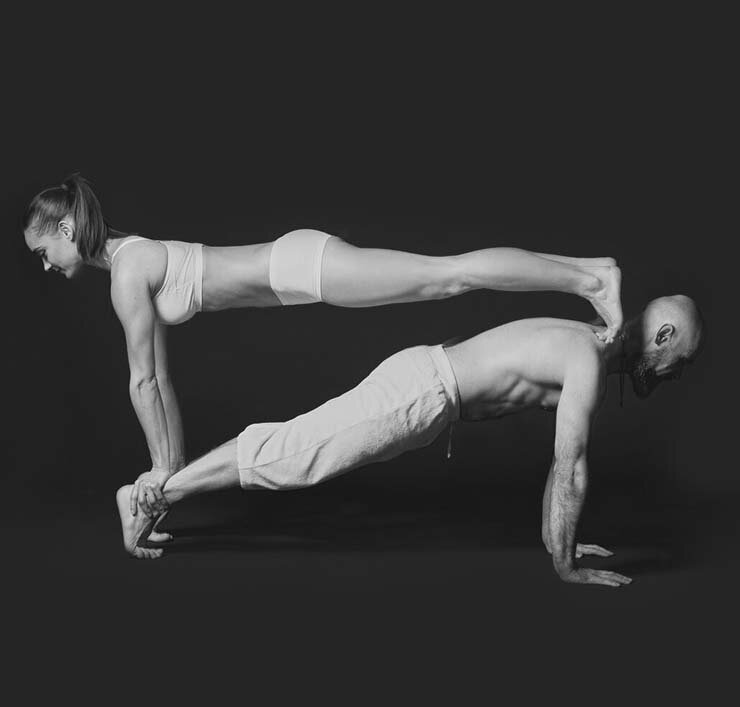
Description: Partner 1 (P1) begins in the Plank position. Partner 2 (P2) enters the Plank position, facing away from P1, with their hands positioned directly outside of P1’s ankles. Gradually, P2 places one foot at a time onto P1’s shoulders, balancing on their toes.
Benefits: These are dynamic power planks! The “flying planker” (P2) is required to stabilize their core as their feet are no longer on solid ground, while the “base planker” (P1) supports additional weight compared to a solo Plank. Take it up a notch by attempting synchronized push-ups together!
6. Double Hand to Big Toe

Description: Stand side-by-side with approximately 1-2 feet of space between you and your partner. Both partners bring their outside legs into the Tree Pose and wrap their inside arms around their partner’s back. Each partner holds onto the foot that’s in the Tree Pose and extends the leg forward. Ensure that both of you are stable before rotating the extended leg outward.
Benefits: This pose eliminates the risk of losing balance by relying on your partner’s support, allowing you to focus on enhancing the flexibility of your extended leg, rather than the challenge of maintaining balance on your standing leg.
7. Lifted Plank

Description: Partner 1 (P1) begins by lying flat on the floor, with arms bent and palms facing upward as if entering Chaturanga, keeping the elbows close to the sides of the body. Partner 2 (P2) starts in a plank position, placing their hands on top of P1’s shins. One at a time, P2 carefully positions the tops of their shins onto P1’s hands. P1 firmly grasps (without excessive force) onto P2’s ankles and pushes upward, while P2 engages its core to maintain a straight plank. (Tip: P1 should imagine pushing P2’s ankles upward as if pushing the floor away during a push-up.)
Benefits: This exercise provides significant strength training! It challenges and strengthens major muscle groups. Who needs CrossFit or weightlifting when you can practice this engaging partner workout?
8. Staff Pose and Supported Handstand
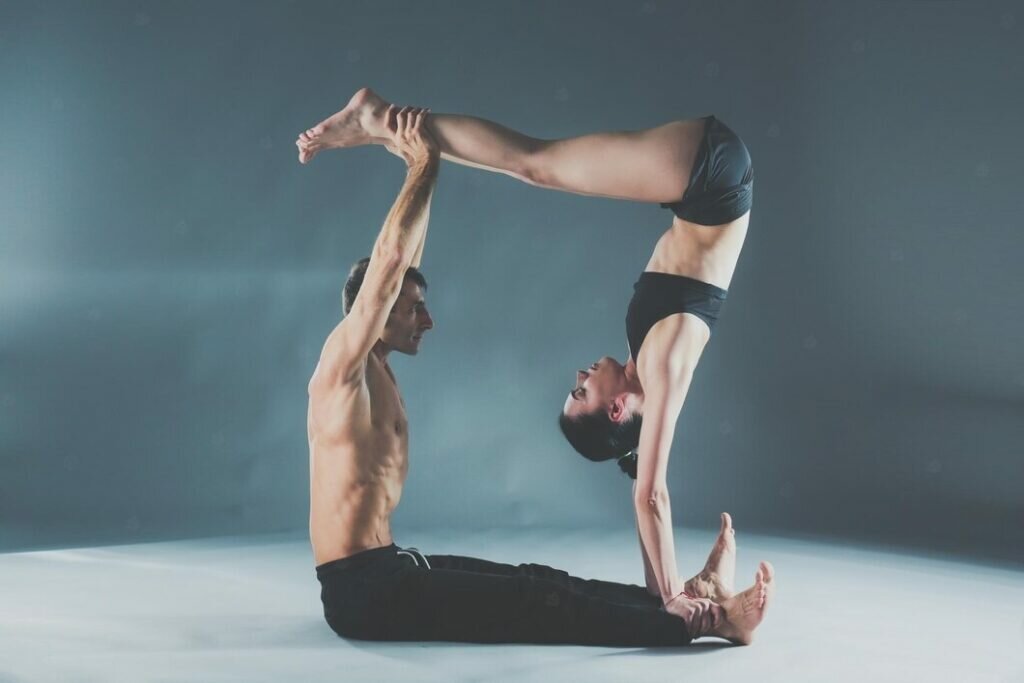
Description: Begin in a Lifted Plank position, with Partner 2 (P2) placing their palms on the mat instead of on top of Partner 1’s (P1) shins. On an exhale, both P1 and P2 engage their core muscles to generate power for the pose: P1 transitions into a Seated Staff position, while P2 performs a Pike by lifting their hips directly over their shoulders and hands. To exit the pose, P1 rolls down.
Benefits: This partner exercise focuses on strength and power. Both positions require substantial core strength, with the base (P1) receiving an effective abdominal workout, while the flyer (P2) strengthens proper form and alignment for a Handstand. The flyer can also attempt to extend one or both legs toward the sky to enter a Handstand position!
Couples Yoga Poses for Connection and Trust
9. Partner Forward Fold
Description: Stand facing each other, holding hands. Take a step back and fold forward, keeping the connection through your hands.
Benefits: This pose improves communication, builds trust, and stretches the hamstrings and back.
10. Double Downward Dog
Description: Start in a downward dog pose, and your partner aligns their body to form an inverted “V” shape next to you.
Benefits: This pose strengthens the arms, shoulders, and core while promoting a sense of togetherness and alignment.
11. Seated Spinal Twist
Description: Sit facing each other with your legs extended. Twist your torsos in opposite directions and hold onto your partner’s hands.
Benefits: This pose improves spinal mobility, releases tension, and promotes a sense of connection.
12. Partner Tree Pose
Description: Stand side by side, placing the inside of your feet against your partner’s leg. Lift your opposite foot and press it against your calf or thigh.
Benefits: This pose enhances balance, focus, and stability while fostering trust and support.
13. Supported Backbend
Description: Stand facing each other and interlace your fingers. Lean back and create a gentle backbend, allowing your partner’s hands to support you.
Benefits: This pose opens the chest, shoulders, and heart center, promoting vulnerability and deepening your connection.
Couples Yoga Poses for Communication and Teamwork
14. Partner Boat Pose
Description: Sit facing each other with your knees bent and feet flat on the floor. Hold each other’s hands and lift your feet off the ground, finding balance.
Benefits: This pose strengthens the core, improves coordination, and requires effective communication and teamwork.
15. Mirror Pose
Description: Stand facing each other and mirror your partner’s movements. Sync your breath and try to match each other’s posture.
Benefits: This pose cultivates synchronization, harmony, and non-verbal communication between partners.
16. Flying Lizard
Description: Begin in a low lunge position. Extend your opposite arm and lift your back leg, allowing your partner to hold and support you.
Benefits: This poses challenges to balance, builds trust, and strengthens the legs and core.
17. Double Plank
Description: Start in a plank position facing each other, with your palms touching. Engage your core and hold the pose together.
Benefits: This pose develops core strength, improves posture, and fosters cooperation.
18. Partner Wheel Pose
Description: Sit facing each other with your feet touching. Hold each other’s forearms and simultaneously lean back, extending into a wheel pose.
Benefits: This pose opens the chest, shoulders, and hip flexors while deepening your sense of connection and support.
Couples Yoga Poses for Relaxation and Intimacy
19. Seated Meditation
Description: Sit back to back in a comfortable cross-legged position. Close your eyes, focus on your breath, and allow yourselves to relax.
Benefits: This pose promotes relaxation, mindfulness, and a shared sense of peace.
20. Heart-to-Heart Hug
Description: Stand facing each other and wrap your arms around each other, pressing your hearts together.
Benefits: This pose fosters intimacy, love, and emotional connection between partners.
21. Partner Butterfly Pose
Description: Sit facing each other with the soles of your feet touching. Hold hands and gently lean forward, feeling the stretch in your hips.
Benefits: This pose releases tension in the hips and groin, promoting openness and vulnerability.
22. Reclining Bound Angle Pose
Description: Sit facing each other with the soles of your feet together, then gently recline onto your backs, maintaining the connection.
Benefits: This pose relaxes the body, opens the hips, and encourages a deep sense of relaxation and trust.
23. Partner Savasana
Description: Lie down next to each other, allowing your bodies to relax completely. Hold hands or place your hands on each other’s hearts.
Benefits: This pose induces a state of deep relaxation, allowing you and your partner to experience profound rest and rejuvenation together.
Conclusion
Couples yoga provides an incredible opportunity to strengthen your relationship while reaping the physical and emotional benefits of yoga. By practicing these 15 couples’ yoga poses, you can enhance your connection, trust, communication, and intimacy. So grab a yoga mat, invite your partner, and embark on this wonderful journey together. Explore the transformative power of couples yoga and watch your relationship thrive.
FAQs
1. Is couples yoga suitable for beginners?
Absolutely! Couples yoga can be enjoyed by practitioners of all levels, including beginners. Just remember to start with gentle poses and listen to your body.
2. Can I practice couples yoga with a friend instead of a partner?
Yes, you can practice couples yoga with a friend if you don’t have a romantic partner. The key is to find someone you trust and communicate effectively with.
3. How often should we practice couples yoga?
It depends on your schedules and preferences. Starting with a few sessions per week and gradually increasing the frequency is a great approach.
4. What if my partner and I have different levels of flexibility?
Embrace the differences! Couples yoga is not about being perfectly in sync. Respect each other’s limitations and support each other’s growth.
5. Can couples yoga help resolve relationship issues?
While couples yoga can improve communication and connection, it may not solve deeper relationship issues. Consider seeking professional guidance if needed.
Disclaimer: The information provided in this article is for educational purposes only and does not constitute medical advice. Consult with a qualified healthcare professional before making any changes to your diet or lifestyle.

